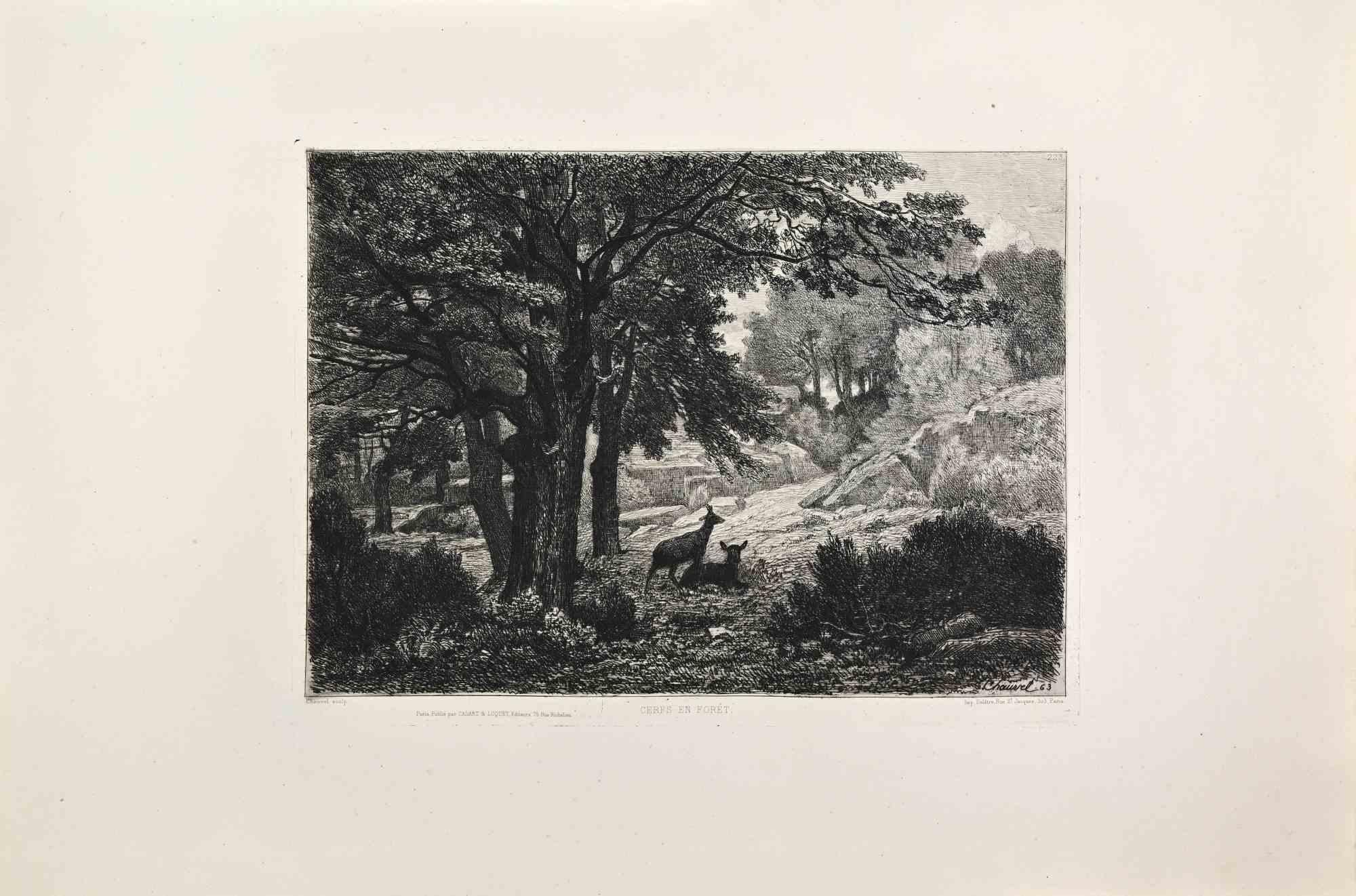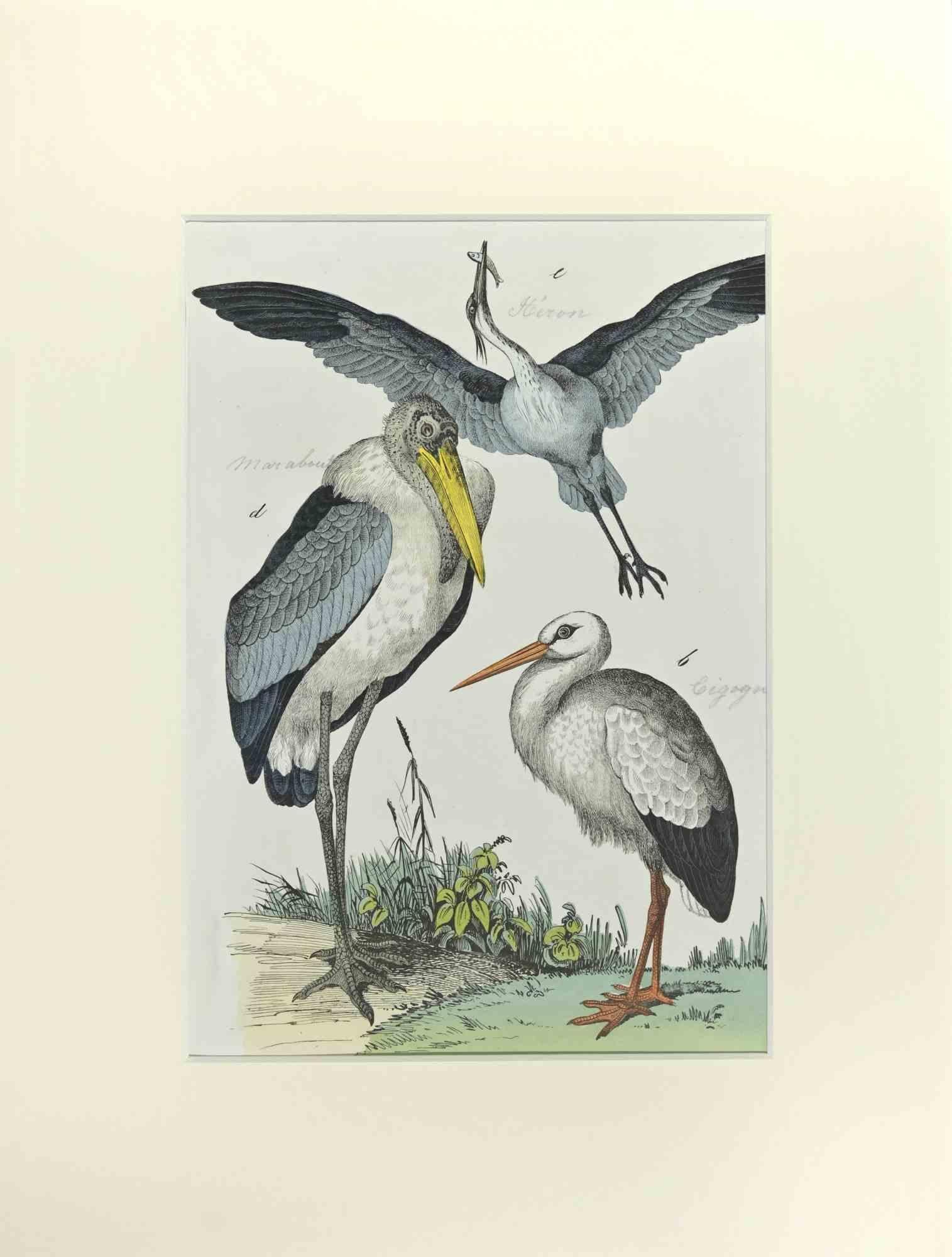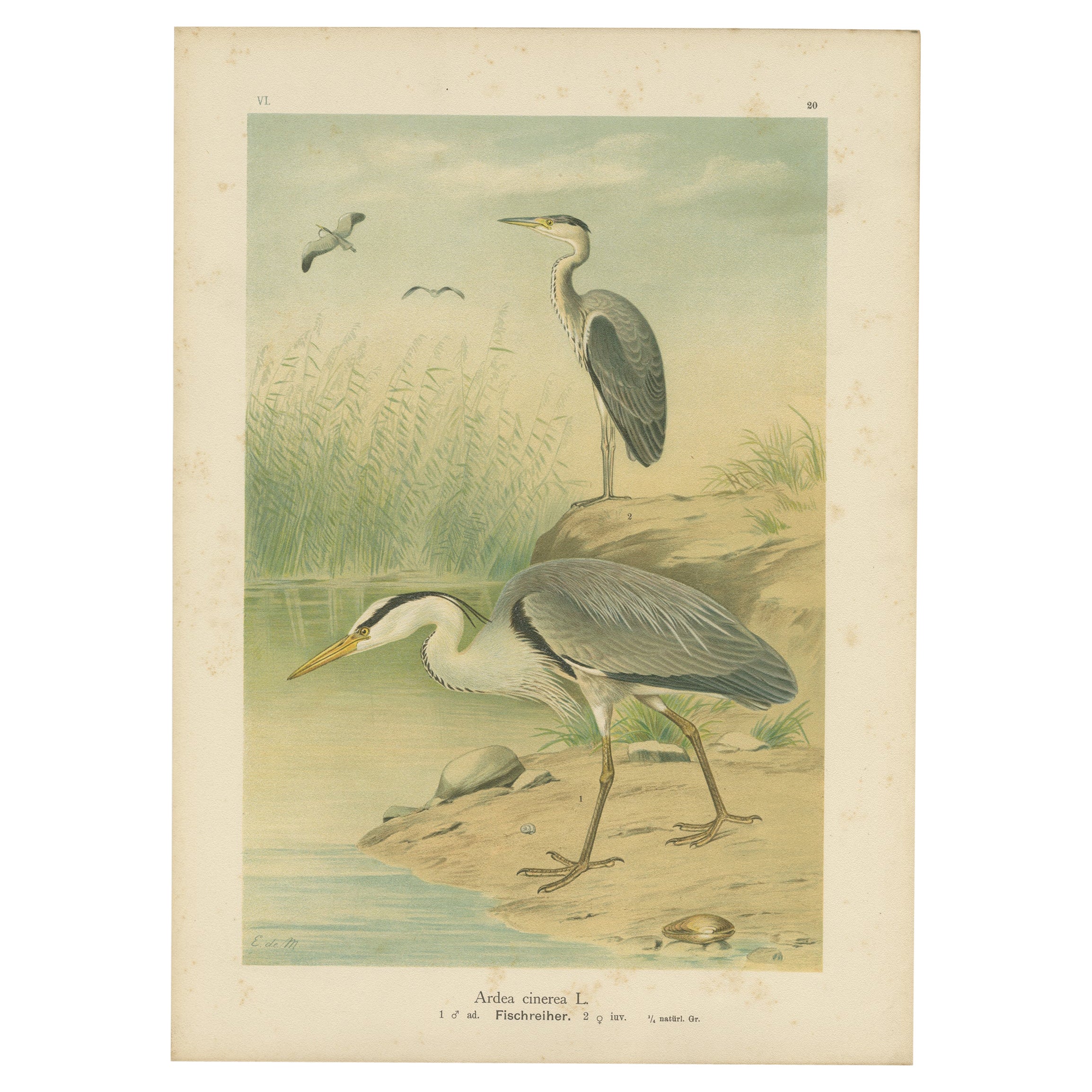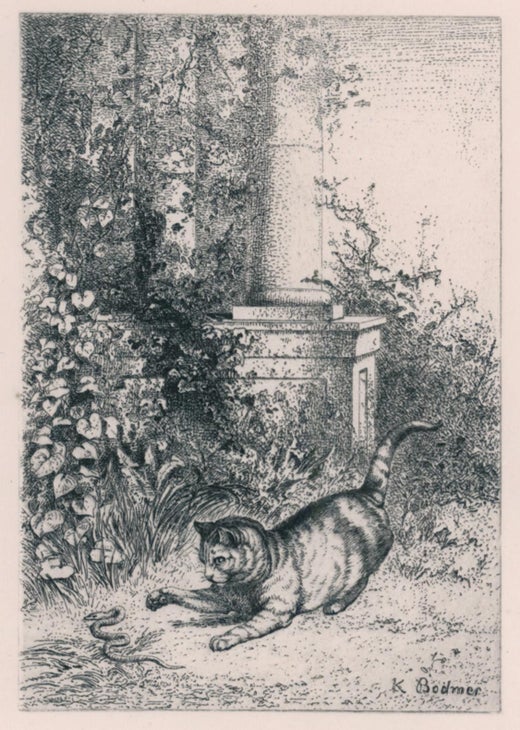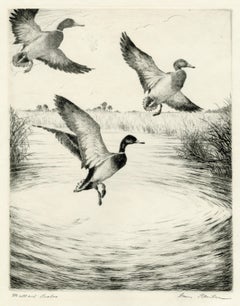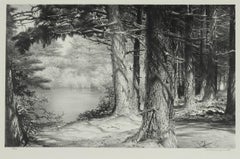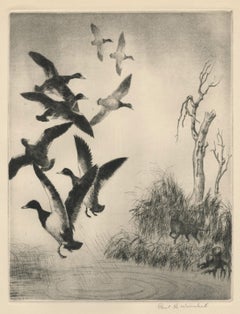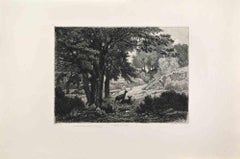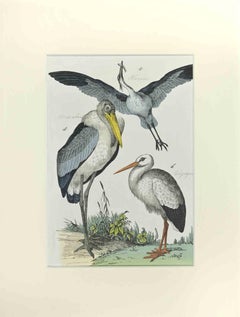Items Similar to Le Soir: Cerf et Herons (The Evening: Stag and Herons)
Want more images or videos?
Request additional images or videos from the seller
1 of 12
Karl BodmerLe Soir: Cerf et Herons (The Evening: Stag and Herons)1858
1858
$550
£416.73
€478.16
CA$773.94
A$850.77
CHF 447.13
MX$10,331.47
NOK 5,577.79
SEK 5,284.57
DKK 3,568.66
About the Item
Le Soir: Cerf et Herons (The Evening: Stag and Herons)
Lithograph printed with brown tint stone, 1858
From: Animaux et Paysages d’apres Nature
Published by Goupil, 1858
Signed in the stone lower left, Karl Bodmer Pinx. et lith. (see photo)
Published by Goupil et Cie, Paris, with their blindstamp center, below image
Printed by Bertauts, Paris (see photo)
Condition: Excellent
One stain verso, not visible on recto
Full sheet
Image size: 11 1/4 x 18 inches
Sheet size: 17 3/4 x 24 3/4 inches
Reference: Delteil 70
IFF 22, No. 1
Karl Bodmer
(1809—1893)
Painter, draftsman, and printmaker. Although he spent only two years in the United States and its territories, Bodmer's depictions of Western Indians and landscape contributed significantly to American art history. Born in Riesbach, near Zurich, he received his early training in Switzerland and then studied in Paris. In 1832 he was engaged by German scientist and explorer Prince Maximilian of Wied-Neuwied as expedition artist to prepare illustrations for a book about the American West. After landing in Boston in July 1832, the party visited East Coast sites before traveling to New Harmony, Indiana, for the winter. From St. Louis, following George Catlin's route of the previous year, they departed in April 1833 to journey up the Missouri River into territorial Montana, farther than Catlin had gone. Before winter set in, they returned only as far as what is now North Dakota. In 1834 they continued back to St. Louis and then to Europe. Bodmer ranked as the best-trained artist to visit the American West in the early nineteenth century. Precisely detailed, skillfully composed, and beautifully colored, his images reflect the wonder and curiosity with which he and Maximilian saw the land and peoples they studied. Bodmer's drawings and paintings, mostly in watercolor, served as the basis for more than eighty hand-colored aquatints he prepared in Paris for an atlas to supplement Maximilian's two-volume German publication, Reise in das innere Nord-America in den Jahren 1832 bis 1834 (1839–41). The trilingual atlas also accompanied French and English editions. (The single-volume Travels in the Interior of North America appeared in 1843). Maximilian's writings and Bodmer's art together provide a comprehensive and scholarly record of the region they explored.
Around 1850, Bodmer settled at Barbizon to paint and etch landscapes, animals, and other scenes. He returned to Paris a few years before his death there.
Courtesy: Oxford Reference
- Creator:Karl Bodmer (1809 - 1893, French, Swiss)
- Creation Year:1858
- Dimensions:Height: 11.25 in (28.58 cm)Width: 18 in (45.72 cm)
- Medium:
- Movement & Style:
- Period:
- Condition:
- Gallery Location:Fairlawn, OH
- Reference Number:Seller: FA58681stDibs: LU1409439322
Karl Bodmer
Karl Bodmer was a Swiss naturalized French painter born on February 11th, 1809, in Zürich, Switzerland. He was initially a watercolorist and an illustrator, and in his old age, he worked a lot with photography. Bodmer died on October 30th, 1893.
About the Seller
5.0
Recognized Seller
These prestigious sellers are industry leaders and represent the highest echelon for item quality and design.
Platinum Seller
Premium sellers with a 4.7+ rating and 24-hour response times
Established in 1978
1stDibs seller since 2013
813 sales on 1stDibs
Typical response time: <1 hour
Associations
International Fine Print Dealers Association
- ShippingRetrieving quote...Shipping from: Fairlawn, OH
- Return Policy
Authenticity Guarantee
In the unlikely event there’s an issue with an item’s authenticity, contact us within 1 year for a full refund. DetailsMoney-Back Guarantee
If your item is not as described, is damaged in transit, or does not arrive, contact us within 7 days for a full refund. Details24-Hour Cancellation
You have a 24-hour grace period in which to reconsider your purchase, with no questions asked.Vetted Professional Sellers
Our world-class sellers must adhere to strict standards for service and quality, maintaining the integrity of our listings.Price-Match Guarantee
If you find that a seller listed the same item for a lower price elsewhere, we’ll match it.Trusted Global Delivery
Our best-in-class carrier network provides specialized shipping options worldwide, including custom delivery.More From This Seller
View AllMallard Drakes (Louisiana Honkers)
Located in Fairlawn, OH
Mallard Drakes (Louisiana Honkers)
Drypoint, c. 1940
Signed in pencil lower right (see photo)
Titled in pencil lower left (see photo)
Note: A famous image by Kleiber. It is was made in a hand colored version which commands a large premium.
Condition: Excellent
Image/Plate size: 9 7/8 x 7 7/8 inches
Hans Kleiber (1887-1967)
Hans Norbert Kleiber, painter, etcher, illustrator, and naturalist, was born in Cologne, Germany on August 24, 1887. He emigrated from Germany to the United States in 1900, settling in Massachusetts before moving to Wyoming. Kleiber first worked in lumber camps before working for the United States Forest Service from 1906 until 1924. One of his duties as a ranger was to monitor the logging camps in the Bighorn Mountains.
Kleiber was primarily self-taught as an artist and it was in the 1920s that he began devoting himself to art. It appears that he first began to work in watercolor and oil but was producing etchings and drypoints as early as 1924. He traversed the mountains of Wyoming, Montana, and Idaho, and his subjects are drawn from the pristine landscapes and wildlife.
Kleiber's first exhibition of his etchings was mounted in 1928 at Goodspeed's Book Shop in Boston. His etching, Crossing the Platte, was included in the 1939 New York World's Fair exhibition, American Art Today. There was an exhibition of fifty of his etchings at the National Museum in 1944, and an exhibition of his watercolors was mounted at the Grand Central Galleries in New York in 1950. Kleiber was a member of the Society of American Etchers and the California Society of Printmakers. He received a silver medal in 1931 from the Printmakers Society of California for his print, Leaving the High Country...
Category
1940s American Realist Animal Prints
Materials
Drypoint
Hidden Pond
By Stow Wengenroth
Located in Fairlawn, OH
Hidden Pond
Lithograph, 1958
Signed in pencil lower right of image
Annotated: Ed/40 in pencil by the artist lower left
Edition: 40
Provenance:
Baldwin-Wallace College, Berea, OH (acc...
Category
1950s American Realist Landscape Prints
Materials
Lithograph
Snow Geese (Wyoming)
Located in Fairlawn, OH
Snow Geese (Wyoming)
Drypoint, c. 1947
Signed in pencil lower right (see photo)
Title in pencil lower left (see photo)
Note: This image is reprodcued in a Photogravure for Ducks Unlimited in 1947. This is the first original drypoint version.
Condition: Excellent
Image/Plate size: 8 3/8 x 6 7/8 inches
Reference: Archives West #101
Kleiber 134
Hans Kleiber (1887-1967)
Hans Norbert Kleiber, painter, etcher, illustrator, and naturalist, was born in Cologne, Germany on August 24, 1887. He emigrated from Germany to the United States in 1900, settling in Massachusetts before moving to Wyoming. Kleiber first worked in lumber camps before working for the United States Forest Service from 1906 until 1924. One of his duties as a ranger was to monitor the logging camps in the Bighorn Mountains.
Kleiber was primarily self-taught as an artist and it was in the 1920s that he began devoting himself to art. It appears that he first began to work in watercolor and oil but was producing etchings and drypoints as early as 1924. He traversed the mountains of Wyoming, Montana, and Idaho, and his subjects are drawn from the pristine landscapes and wildlife.
Kleiber's first exhibition of his etchings was mounted in 1928 at Goodspeed's Book Shop in Boston. His etching, Crossing the Platte, was included in the 1939 New York World's Fair exhibition, American Art Today. There was an exhibition of fifty of his etchings at the National Museum in 1944, and an exhibition of his watercolors was mounted at the Grand Central Galleries in New York in 1950. Kleiber was a member of the Society of American Etchers and the California Society of Printmakers. He received a silver medal in 1931 from the Printmakers Society of California for his print, Leaving the High Country...
Category
1940s American Realist Animal Prints
Materials
Drypoint
untitled (Duck taking to flight, flushed by a dog)
By Paul H. Winchell
Located in Fairlawn, OH
untitled (Duck taking to flight, flushed by a dog)
Drypoint & Aquatint, c. 1940
signed lower right
Created while the artist was a commercial artist working in Minneapolis, after his ...
Category
1940s American Realist Animal Prints
Materials
Drypoint
L'Abreuvoir (The Watering Trough)
By Auguste Louis Lepère
Located in Fairlawn, OH
L'Abreuvoir (The Trough)
Woodcut printed in two shades of brown on paper, mounted
Signed by the artist in pencil lower right (see photo)
Signed with artist's monogram in the stone upper right: AL
Dedicated in ink lower left: á Sagot (see photo)
Annotated in ink lower right: 1/5 HT (1 of 5 Hors Triage [apart from the printing])
(see photo)
Image: 12 x 15-7/8" (30.6 x 40.3 cm.)
Mount: 19-5/8 x 25-1/2" (50 x 64.9 cm.)
Condition: Excellent
Reference: Lotz-Brissonneau 521
Auguste Louis Lepère...
Category
Early 1900s Prints and Multiples
Materials
Woodcut
The River Barge
By David Cox
Located in Fairlawn, OH
The River Barge
Pen and ink on paper on laid paper, mounted in English drum mount , c. 1810
Unsigned
Condition: Slight sun staining to sheet and mount in the window (see photo)
Image/sheet size: 5 1/4 x 6 11/16 inches
Sight: : 5-3/4 x 7-1/4"
Frame: 13-3/8 x 14-3/8"
Provenance: Colnaghi, London (see photo of label)
David Cox (29 April 1783 – 7 June 1859) was an English landscape painter, one of the most important members of the Birmingham School of landscape artists and an early precursor of Impressionism.
He is considered one of the greatest English landscape painters, and a major figure of the Golden age of English watercolour.
Although most popularly known for his works in watercolour, he also painted over 300 works in oil towards the end of his career, now considered "one of the greatest, but least recognised, achievements of any British painter.
His son, known as David Cox the Younger (1809-1885), was also a successful artist.
Early life in Birmingham, 1783–1804
Cox's birthplace in Deritend, Birmingham, illustrated by Samuel Lines
Cox was born on 29 April 1783 on Heath Mill Lane in Deritend, then an industrial suburb of Birmingham. His father was a blacksmith and whitesmith about whom little is known, except that he supplied components such as bayonets and barrels to the Birmingham gun trade. Cox's mother was the daughter of a farmer and miller from Small Heath to the east of Birmingham. Early biographers record that "she had had a better education than his father, and was a woman of superior intelligence and force of character." Cox was initially expected to follow his father into the metal trade and take over his forge, but his lack of physical strength led his family to seek opportunities for him to develop his interest in art, which is said to have first become apparent when the young Cox started painting paper kites while recovering from a broken leg.
By the late 18th century Birmingham had developed a network of private academies teaching drawing and painting, established to support the needs of the town's manufacturers of luxury metal goods, but also encouraging education in fine art, and nurturing the distinctive tradition of landscape art of the Birmingham School. Cox initially enrolled in the academy of Joseph Barber in Great Charles Street, where fellow students included the artist Charles Barber and the engraver William Radclyffe, both of whom would become important lifelong friends.
At the age of about 15 Cox was apprenticed to the Birmingham painter Albert Fielder, who produced portrait miniatures and paintings for the tops of snuffboxes from his workshop at 10 Parade in the northwest of the town. Early biographers of Cox record that he left his apprenticeship after Fielder's suicide, with one reporting that Cox himself discovered his master's hanging body, but this is probably a myth as Fielder is recorded at his address in Parade as late as 1825. At some time during mid-1800 Cox was given work by William Macready the elder at the Birmingham Theatre, initially as an assistant grinding colours and preparing canvases for the scene painters, but from 1801 painting scenery himself and by 1802 leading his own team of assistants and being credited in plays' publicity.
London, 1804–1814
In 1804 Cox was promised work by the theatre impresario Philip Astley and moved to London, taking lodgings in 16 Bridge Row, Lambeth. Although he was unable to get employment at Astley's Amphitheatre it is likely that he had already decided to try to establish himself as a professional artist, and apart from a few private commissions for painting scenery his focus over the next few years was to be on painting and exhibiting watercolours. While living in London, Cox married his landlord's daughter, Mary Agg and the couple moved to Dulwich in 1808.
David Cox Travellers on a Path, pencil and brown wash.
In 1805 he made his first of many trips to Wales, with Charles Barber, his earliest dated watercolours are from this year. Throughout his lifetime he made numerous sketching tours to the Home Counties, North Wales, Yorkshire, Derbyshire and Devon.
Cox exhibited regularly at the Royal Academy from 1805. His paintings never reached high prices, so he earned his living mainly as a drawing master. His first pupil, Colonel the Hon.H. Windsor (the future Earl of Plymouth) engaged him in 1808, Cox went on to acquire several other aristocratic and titled pupils. He also went on to write several books, including: Ackermanns' New Drawing Book (1809); A Series of Progressive Lessons (1811); Treatise on Landscape Painting (1813); and Progressive Lessons on Landscape (1816). The ninth and last edition of his series Progressive Lessons, was published in 1845.
By 1810 he was elected President of the Associated Artists in Water Colour. In 1812, following the demise of the Associated Artists, he was elected as associate of the Society of Painters in Water Colour (the old Water Colour Society). He was elected a Member of the Society in 1813, and exhibited there every year (except 1815 and 1817) until his death.
Hereford, 1814–1827
In the summer of 1813 Cox was appointed as the drawing master of the Royal Military College in Farnham, Surrey, but he resigned shortly afterwards, finding little sympathy with the atmosphere of a military institution. Soon after that he applied to a newspaper advertisement for a position as drawing master for Miss Crouchers' School for Young Ladies in Hereford and in Autumn 1814 moved to the town with his family. Cox taught at the school in Widemarsh Street until 1819, his substantial salary of £100 per year requiring only two-day's work per week, allowing time for painting and the taking of private pupils.
Cox's reputation as both a painter and a teacher had been building over previous years, as indicated by his election as a member of the Society of Painters in Water Colours and his inclusion in John Hassell's 1813 book Aqua Pictura, which claimed to present works by "all of the most approved water coloured draftsmen". The depression that accompanied the end of the Napoleonic Wars had caused a contraction in the art market, however, and by 1814 Cox had been very short of money, requiring a loan from one of his pupils to pay even for the move to Hereford. Despite its financial advantages and its proximity to the scenery of North Wales and the Wye Valley, the move to Hereford marked a retreat in terms of his career as a painter: he sent few works to the annual exhibition of the Society of Painters in Water Colours during his first years away from London and not until 1823 would he again contribute more than 20 pictures.
Between 1823 and 1826 he had Joseph Murray Ince as a pupil.
London, 1827–1841
He made his first trip to the Continent, to Belgium and the Netherlands in 1826 and subsequently moved to London the following year.
He exhibited for the first time with the Birmingham Society of Artists in 1829, and with the Liverpool Academy in 1831. In 1839, two of Cox's watercolours were bought from the Old Water Colour Society exhibition by the Marquis of Conynha for Queen Victoria.
Birmingham, 1841–1859
Greenfield House in Harborne, Birmingham – where Cox lived from 1841 until his death in 1859 .
In May 1840 Cox wrote to one of his Birmingham friends: "I am making preparations to sketch in oil, and also to paint, and it is my intention to spend most of my time in Birmingham for the purpose of practice". Cox had been considering a return to painting in oils since 1836 and in 1839 had taken lessons in oil painting from William James Müller, to whom he had been introduced by mutual friend George Arthur Fripp. Hostility between the Society of Painters in Water Colours and the Royal Academy made it difficult for an artist to be recognised for work in both watercolour and oil in London, however, and it is likely that Cox would have preferred to explore this new medium in the more supportive environment of his home town. By the early 1840s his income from sales of his watercolours was sufficient to allow him to abandon his work as a drawing master, and in June 1841 he moved with his wife to Greenfield House in Harborne, then a village on Birmingham's south western outskirts. It was this move that would enable the higher levels of freedom and experimentation that were to characterise his later work.
The elderly Cox pictured by Samuel Bellin in 1855.
In Harborne, Cox established a steady routine – working in watercolour in the morning and oils in the afternoon. He would visit London every spring to attend the major exhibitions, followed by one or more sketching excursions, continuing the pattern that he had established in the 1830s. From 1844 these tours evolved into a yearly trip to Betws-y-Coed in North Wales to work outdoors in both oil and watercolour, gradually becoming the focus for an annual summer artists colony that continued until 1856 with Cox as its "presiding genius".
Cox's experience of trying to exhibit his oils in London was short and unsuccessful: in 1842 he made his only submission to the Society of British Artists; one oil painting was exhibited at each of the British Institution and the Royal Academy in 1843; and two oil paintings were exhibited at the Royal Academy in 1844 – the last that would be exhibited in London during his lifetime.
Cox showed regularly at the Birmingham Society of Arts and its successor, the Birmingham Society of Artists, becoming a member in 1842.
Cox suffered a stroke on 12 June 1853 that temporarily paralysed him, and permanently affected his eyesight, memory and coordination.
By 1857 however, his eyesight had deteriorated. An exhibition of his work was arranged in 1858 by the Conversazione Society Hampstead, and in 1859 a retrospective exhibition was held at the German Gallery Bond Street, London. Cox died several months later. He was buried in the churchyard of St Peters, Harborne, Birmingham, under a chestnut tree, alongside his wife Mary.
Work
Early work
In the spring of 1811 Cox made a small number of notable works in oils during a visit to Hastings with his family. It is not known why he didn't continue working in this medium at the time, but the five known surviving examples were described in 1969 as "surely some of the most brilliant examples of the genre in England".
Mature work
Cox reached artistic maturity after his move to Hereford in 1814. Although only two major watercolours can confidently be traced to the period between Cox's arrival in the town and the end of the decade, both of these – Butcher's Row, Hereford of 1815 and Lugg Meadows, near Hereford of 1817 – mark advances on his earlier work.
Later work
Cox's later work produced after his move to Birmingham in 1841 was marked by simplification, abstraction and a stripping down of detail. His art of the period combined the breadth and weight characteristic of the earlier English watercolour school, together with a boldness and freedom of expression comparable to later impressionism. His concern with capturing the fleeting nature of weather, atmosphere and light was similar to that of John Constable, but Cox stood apart from the older painter's focus on capturing material detail, instead employing a high degree of generalisation and a focus on overall effect.
The quest for character over precision in representing nature was an established characteristic of the Birmingham School of landscape artists with which Cox had been associated early in his life, and as early as 1810 Cox's work had been criticised for its "sketchiness of finish" and "cloudy confusion of objects", which were held to betray "the coarseness of scene-painting". During the 1840s and 1850s Cox took this "peculiar manner" to new extremes, incorporating the techniques of the sketch into his finished works to a far greater degree.
Cox's watercolour technique of the 1840s was sufficiently different from his earlier methods to need explanation to his son in 1842, despite the fact that his son had been helping him teach and paint since 1827. The materials used for his later works in watercolour also differed from his earlier periods: he used black chalk instead of graphite pencil as his primary drawing medium, and the rough and absorbent "Scotch" wrapping paper for which he became well-known – both of these were related to his development of a rougher and freer style.
Influence and legacy
By the 1840s Cox, alongside Peter De Wint and Copley Fielding, had become recognised as one of the leading figures of the English landscape watercolour style of the first half of the 19th century. This judgement was complicated by reaction to the rougher and bolder style of Cox's later Birmingham work, which was widely ignored or condemned. While by this time De Wint and Fielding were essentially continuing in a long-established tradition, Cox was creating a new one.
A group of young artists working in Cox's watercolour style emerged well before his death, including William Bennett, David Hall McKewan and Cox's son David Cox Jr. By 1850 Bennett in particular had become recognised as "perhaps the most distinguished among the landscape painters" for his Cox-like vigorous and decisive style. Such early followers concentrated on the example of Cox's more moderate earlier work and steered clear of what were then seen as the excesses of Cox's later years. During a period dominated by sleek and detailed picturesque landscape, however, they were still condemned by publications such as The Spectator as "the 'blottesque' school", and failed to establish themselves as a cohesive movement.
John Ruskin in 1857 condemned the work of the Society of Painters in Water-colours as "a kind of potted art, of an agreeable flavour, suppliable and taxable as a patented commodity", excluding only the late work of Cox, about which he wrote "there is not any other landscape which comes near these works of David Cox in simplicity or seriousness".
An 1881 book, A Biography of David Cox: With Remarks on His Works and Genius, was based on a manuscript by Cox's friend William Hall, edited and expanded by John Thackray Bunce, editor of the Birmingham Daily Post.
There are two Blue Plaque memorials commemorating him at 116 Greenfield Road, Harborne, Birmingham, and at 34 Foxley Road, Kennington, London, SW9, where he lived from 1827. It can also be seen at the David Cox exhibition in Birmingham.
His pupils included Birmingham architectural artist, Allen Edward...
Category
1810s Romantic Landscape Drawings and Watercolors
Materials
Ink
You May Also Like
Le matin : Cerf et Biches, 1858
By Karl Bodmer
Located in Atlanta, GA
Swiss-born Karl Bodmer (1809–1893) was one of the first and most accomplished European artists to document the landscape of the North American interior and its Indigenous peoples. He...
Category
19th Century Realist Landscape Drawings and Watercolors
Materials
Lithograph
Cerfs en Foret - Etching by Théophile Narcisse Chauvel - 1860s
By Theophile Narcisse Chauvel
Located in Roma, IT
Cerfs en Foret is a black and White etching realized by Théophile Narcisse Chauvel in the 1860s.
Titled in the lower.
Image size: 24x31.
Very good impression with wide margins a...
Category
1860s Modern Figurative Prints
Materials
Etching
Les cerfs qui ce battent dans la foret
By Karl Bodmer
Located in Atlanta, GA
Swiss-born Karl Bodmer (1809–1893) was one of the first and most accomplished European artists to document the landscape of the North American interior and its Indigenous peoples. He...
Category
19th Century Realist Animal Paintings
Materials
Oil
Heron and Stork - Etching by Johann Friedrich Naumann - 1840
Located in Roma, IT
Heron and Stork is an Etching hand colored realized by Gotthilf Heinrich von Schubert - Johann Friedrich Naumann, Illustration from Natural history of birds in pictures, published by...
Category
1840s Modern Figurative Prints
Materials
Etching
Antique Bird Print of the Grey Heron by Naumann, circa 1895
Located in Langweer, NL
Grey Heron by E. de Maes, Antique Bird Lithograph Ardea cinerea c.1895
This elegant antique ornithological print depicts the *Ardea cinerea*,...
Category
Antique Late 19th Century Prints
Materials
Paper
The Heron by the River: atmospheric 19th Century Naturalist school landscape
Located in Norwich, GB
One wonderful thing about this painting is its light. It’s pitch-perfect: if it were a tad
darker, it would be gloomy; a tad lighter, and it there would be less to discover. The joy ...
Category
1860s Naturalistic Landscape Paintings
Materials
Canvas, Oil
More Ways To Browse
Antique Stag
Antique Heron
Gary Hodges
George Wright Print
Gifford John
Giraffe Etching
Harrison Begay
Henry Moore Zoo
I Destroyed The Tennis Ball
Irish Water Spaniel
Jack Coughlin
John Gould Ducks
Keith Haring Secret Pastures
Kenojuak Ashevak
Le Singe Et Le Leopard
Leon Danchin On Sale
Louis Prang Chromolithograph
Man O War Horse

